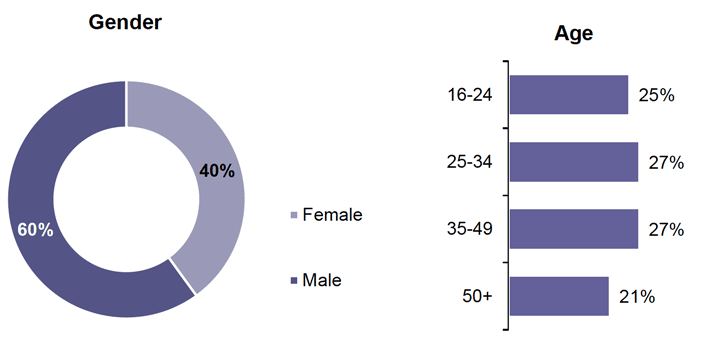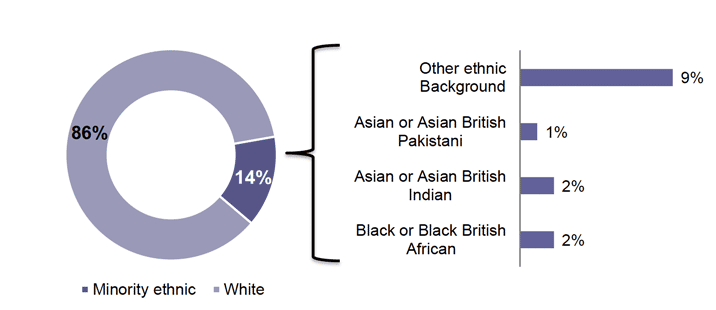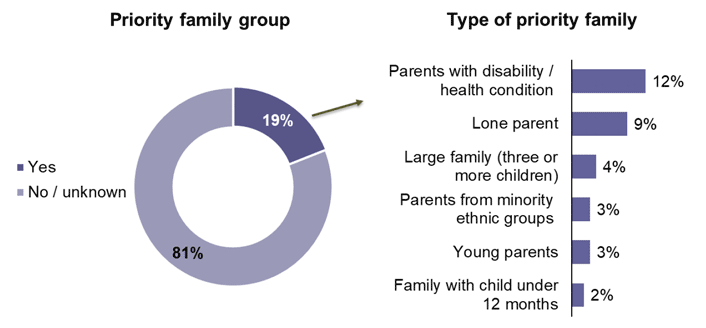Fair Start Scotland: evaluation report 4 - participant phone survey - year 3
Part of a series of reports on the evaluation of Fair Start Scotland (FSS) employability services. The report presents more detailed findings from a representative telephone survey of FSS participants and explores their experiences in the third year of delivery
Profile of respondents
This section provides an overview of the participants who joined the Fair Start Scotland service during 2020. It covers their characteristics such as age, gender and qualification level, any health conditions they experience, and employment history prior to entering support. There is also analysis of the proportion of participants classified within 'priority family groups'.[2] Any interesting significant differences between the 2020 cohort, 2019 cohort and the 2018 cohort are also noted.
Participant characteristics
Age and gender
Three-fifths (60 per cent) of the 2020 cohort identified as male and two-fifths (40 per cent) as female. In line with the goal to engage more female participants in FSS, this represents an increase of 4 percentage points compared to the proportion of females in the 2018 cohort at Wave 1 and the 2019 cohort at Wave 2.
Similar to previous cohorts, the 2020 cohort was evenly spread between older and younger participants; between 21 per cent and 27 per cent fell into each of the age bands. The full breakdown can be found in Figure 1.

Source: IFF Research telephone survey of FSS customers: H1_W3/H2_W3. Do you identify as...?/Which of the following age bands do you fall into? Base: All 2020 cohort (663)
With regard to the age profile of participants, over time there has been a steady increase in younger people joining the service. In the 2018 cohort at Wave 1, 16 – 24 year olds formed 16 per cent of the cohort, increasing to 21 per cent in 2019 at Wave 2 and 25 per cent in 2020.
Qualification level
Around three-quarters (77 per cent) of the 2020 cohort held National 1 - 5 or equivalent qualifications or above, with one-quarter (26 per cent) having obtained the highest qualification level (Level 8+). The highest level of qualification achieved by 2020 respondents is shown in Figure 2.
Comparing across cohorts, there was a tendency for participants of the 2020 cohort to hold slightly higher-level qualifications than those in previous cohorts. A higher proportion of the 2020 cohort achieved Level 8+ (26 per cent) when compared to the 2019 cohort at Wave 2 (18 per cent) and the 2018 cohort at Wave 1 (13 per cent). That said, there has been no increase in the proportion of respondents with National 1 – 5 or equivalent qualifications as a minimum from 2019 (77 per cent) to 2020 (77 per cent), suggesting that respondents in the 2020 cohort were just as likely as those in the previous year to hold any form of qualification, but that the qualification they held was likely to be of a higher level.

Source: IFF Research telephone survey of FSS customers: H3_W3. What is the highest level of qualification that you have achieved? Base: All 2020 cohort (663)
Female participants were more likely than male participants to have achieved a Level 8+ qualification (32 per cent vs. 22 per cent). This was also related to age; a higher proportion of those between the ages of 25 – 49 held this level of qualification (32 per cent), compared to 21 per cent of those 50 or over.
Ethnicity
The majority of the 2020 cohort was white (86 per cent), and 14 per cent were from minority ethnic backgrounds. There was an increase in participation amongst people from minority ethnic backgrounds from 6 per cent in 2018 at Wave 1 and 7 per cent in 2019 at Wave 2.

Source: IFF Research telephone survey of FSS customers: H4_W3. Which of the following best describes your ethnic background? Base: All 2020 cohort who agreed to provide demographic details (597).
Priority families
The Scottish Government has identified a number of priority family groups. These are family types that have a higher-than-average risk of child poverty. These include lone parents, young parents (under 25 years old), parents from minority ethnic groups, parents with a disability / health condition, families with three or more children, and families with a child under 12 months of age. There is a desire to further understand the impact of employability support on tackling child poverty, so it is key that FSS reaches these parents.
Around a fifth (19 per cent) of the 2020 cohort were identified as part of a priority family group, most commonly these were parents with a disability / health condition (12 per cent). Around one in ten (9 per cent) of the cohort were lone parents, 4 per cent were large families, 3 per cent were parents from minority ethnic groups, 3 per cent were young parents, and 2 per cent had a child under 12 months. This is shown in Figure 4.

Source: IFF Research telephone survey of FSS customers, Base: 2020 cohort (663)
The makeup of the 2019 and 2020 cohorts were similar with regard to priority families. Just over a fifth (21 per cent) of the 2019 cohort were identified as part of a priority family group. Thirteen per cent were parents with a disability / health condition, around one in ten (11 per cent) were lone parents, one in twenty (5 per cent) were large families and 4 per cent were parents from minority ethnic groups.[3]
Contact
Email: Arfan.iqbal@gov.scot
There is a problem
Thanks for your feedback